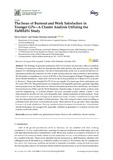Citation link:
http://dx.doi.org/10.25819/ubsi/9046Files in This Item:
| File | Description | Size | Format | |
|---|---|---|---|---|
| Hirsch_Adarkwah_The_issue_of_burnout.pdf | 339.25 kB | Adobe PDF |  View/Open |
| Dokument Type: | Article | metadata.dc.title: | The issue of burnout and work satisfaction in younger GPs - a cluster analysis utilizing the HaMEdSi study | Authors: | Adarkwah, Charles Christian Hirsch, Oliver |
Institute: | Fakultät V - Lebenswissenschaftliche Fakultät | Free keywords: | Burnout, Cluster analysis, General practitioners, Job satisfaction, Primary health care | Dewey Decimal Classification: | 610 Medizin, Gesundheit | GHBS-Clases: | VUD HUF HWJ |
Issue Date: | 2018 | Publish Date: | 2021 | Source: | International Journal of Environmental Research and Public Health. 2018; 15(10) : 2190. - https://doi.org/10.3390/ijerph15102190 | Abstract: | The shortage of general practitioners (GPs) in Germany has become a relevant problem. Therefore, it is important to find the determinants that make primary care more attractive, and which support GPs remaining in practice. Our aim in this exploratory study was to search for relevant GP subgroups and their characteristics in order to find starting points for improvements or interventions. We attempted a comprehensive survey of all GPs in the German region of Siegen-Wittgenstein with about 280,000 inhabitants. There were 158 GPs in the total population; 85 of these (53.8%) took part in the study. There were 64 male GPs (75.3%) in our sample. The mean age of the participants was 53.5 years (SD 8.93). The questionnaire was composed of demographic questions, questions regarding future perspectives, the Motivation for Medical Education Questionnaire (MoME-Q), the Maslach Burnout Inventory (MBI), and the Work Satisfaction Questionnaire. K-means cluster analyses were used for subgrouping. A 2-cluster solution had good statistical quality criteria. Cluster 1 was characterised by elderly GPs who more frequently had a resident physician in their practices. These GPs had low burnout scores and high work satisfaction scores. Cluster 2 consisted of younger GPs who less frequently had a resident in their practices. They had average burnout scores according to published norms and lower work satisfaction scores. There seems to be an age cohort effect regarding burnout and work satisfaction. Having a resident physician seems to be protective. Interventions should be designed for younger GPs, especially members of generation Y, to reduce burnout and improve work satisfaction. |
Description: | Finanziert aus dem DFG-geförderten Open-Access-Publikationsfonds der Universität Siegen für Zeitschriftenartikel |
DOI: | http://dx.doi.org/10.25819/ubsi/9046 | URN: | urn:nbn:de:hbz:467-18579 | URI: | https://dspace.ub.uni-siegen.de/handle/ubsi/1857 |
| Appears in Collections: | Geförderte Open-Access-Publikationen |
This item is protected by original copyright |
Page view(s)
362
checked on Nov 30, 2024
Download(s)
86
checked on Nov 30, 2024
Google ScholarTM
Check
Altmetric
Items in DSpace are protected by copyright, with all rights reserved, unless otherwise indicated.

